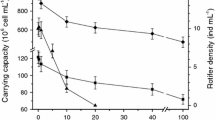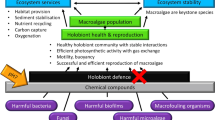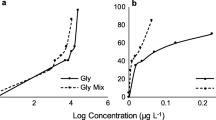Abstract
The toxicity of three antifoulants (Sea-Nine, Irgarol, and TBT) was determined individually and in mixtures in two tests with microalgae. Effects on periphyton community photosynthesis and reproduction of the unicellular green algae Scenedesmus vacuolatus were investigated. The tested antifoulants were highly toxic in both tests. Observed mixture toxicities were compared with predictions derived from two concepts: Independent Action (IA), assumed to be more relevant for the tested mixtures that were composed of dissimilarly acting substances, and Concentration Addition (CA), regarded as a reasonable worst-case approach in predictive mixture hazard assessment. Despite the corresponding mechanistic basis, IA failed to provide accurate predictions of the observed mixture toxicities. Results show the same pattern in both assays. Mixture effects at high concentrations were slightly overestimated and effects at low concentrations were slightly underestimated. Maximum observed deviations between observed and IA-predicted concentrations amount to a factor of 4. The suggested worst-case approach using CA was protective only in effect regions above 20%. Nevertheless, the application of any concept that accounts for possible mixture effects is more realistic than the present chemical-by-chemical assessment.




Similar content being viewed by others

References
Altenburger R, Backhaus T, Boedeker W, Faust M, Scholze M, Grimme LH (2000) Predictability of the toxicity of multiple chemical mixtures to Vibrio fischeri: Mixtures composed of similarly acting chemicals. Environ Toxicol Chem 19(9):2341–2347
Altenburger R, Nendza M, Schuurmann G (2003) Mixture toxicity and its modeling by quantitative structure-activity relationships. Environ Toxicol Chem 22(8):1900–1915
Altenburger R, Walter H, Grote M (2004) What contributes to the combined effect of a complex mixture? Environ Sci Technol 38(23):6353–6362
Arrhenius Å, Grönvall F, Scholze M, Backhaus T, Blanck H (2004) Predictability of the mixture toxicity of 12 similarly acting congeneric inhibitors of photosystem II in marine periphyton and epipsammon communities. Aquat Toxicol 68(4):351–367
Backhaus T, Altenburger R, Boedeker W, Faust M, Scholze M, Grimme LH (2000a) Predictability of the toxicity of a multiple mixture of dissimilarly acting chemicals to Vibrio fischeri. Environ Toxicol Chem 19(9):2348–2356
Backhaus T, Scholze M, Grimme LH (2000b) The single substance and mixture toxicity of quinolones to the bioluminescent bacterium Vibrio fischeri. Aquat Toxicol 49:49–61
Backhaus T, Arrhenius Å, Blanck H (2004) Toxicity of a mixture of dissimilarly acting substances to natural algal communities: Predictive power and limitations of independent action and concentration addition. Environ Sci Technol 38(23):6363–6370
Basheer C, Tan KS, Lee HK (2002) Organotin and Irgarol-1051 contamination in Singapore coastal waters. Marine Pollut Bull 44(7):697–703
Berard A, Dorigo U, Mercier I, Becker-van Slooten K, Grandjean D, Leboulanger C (2003) Comparison of the ecotoxicological impact of the triazines Irgarol 1051 and atrazine on microalgal cultures and natural microalgal communities in Lake Geneva. Chemosphere 53(8):935–944
Biselli S, Bester K, Huhnerfuss H, Fent K (2000) Concentrations of the antifouling compound Irgarol 1051 and organotins in water and sediments of German North and Baltic Sea marinas. Marine Pollut Bull 40(3):233–243
Blanck H, Dahl B (1996) Pollution-induced community tolerance (PICT) in in marine periphyton in a gradient of tri-n-butyltin (TBT) contamination. Aquat Toxicol 35(1):59–77
Blanck H, Wängberg S-Å (1988) Validity of an ecotoxicological test system: short-term and long-term effects of arsenate on marine periphyton communities in laboratory systems. Can J Fish Aquat Sci 10:1807–1815
Bliss CI (1939) The toxicity of poisons applied jointly. Ann J Appl Biol 585–615
Boedeker W, Drescher K, Altenburger R, Faust M, Grimme LH (1993) Combined effects of toxicants: the need and soundness of assessment approaches in ecotoxicology. Sci Total Environ (Suppl) 931–938
Callow ME, Finlay JA (1995) A simple method to evaluate the potential for degradation of antifouling biocides. Biofouling 9(2):153–165
Callow ME, Willingham L, Shade WD, Hurt SS, Jacobson AH, Reinert K (1996) Degradation of antifouling biocides. Biofouling (1-3):239–249
Collier PJ, A R, Waigh RD, Douglas KT, Austin P, Gilbert P (1990a) Chemical reactivity of some isothiazolone biocides. J Appl Bacteriol 69:578–584
Collier PJ, Ramsey AJ, Austin P, Gilbert P (1990b) Growth inhibitory and biocidal activity of some isothiazolone biocides. J Appl Bacteriol 69:569–577
Collier PJ, Austin P, Gilbert P (1991) Isothiazolone biocides: enzyme-inhibition pro-drugs. Int J Pharmaceut 74:195–201
Dahl B, Blanck H (1996a) Pollution-induced community tolerance (PICT) in periphyton communities established under tri-n-butyltin (TBT) stress in marine microcosms. Aquat Toxicol 34:305–325
Dahl B, Blanck H (1996b) Toxic effects of the antifouling agent Irgarol 1051 on periphyton communities in coastal water microcosms. Mar Pollut Bull 342–350
Diehl MA, Fearnside KB, S CJ (1999) Antifungal mechanism of dichloro-n-octyl isothiazolone. Conference of Society for Industrial Microbiology (SIM), Washington, DC
Dunnett C (1964) New tables for multiple comparisons with a control. Biometrics 20:482–491
Efron B, Tibshirani R (1993) An introduction to the bootstrap 1st ed. Chapman & Hall, London
Faust M (1999) Kombinationseffekte von Schadstoffen auf aquatische Organismen; Prüfung der Vorhersagbarkeit am Beispiel einzelliger Grünalgen. Bremen, University of Bremen
Faust M, Altenburger R, Backhaus T, Boedeker W, Scholze M, Grimme LH (2000) Predictive assessment of the aquatic toxicity of multiple chemical mixtures. J Environ Qual 29:1063–1068
Faust M, Altenburger R, Backhaus T, Blanck H, Boedeker W, Gramatica P, Hamer V, Scholze M, Vighi M, Grimme LH (2001) Predicting the joint algal toxicity of multi-component s-triazine mixture at low-effect concentrations of individual toxicants. Aquat Toxicol 56:13–32
Faust M, Altenburger R, Backhaus T, Blanck H, Boedeker W, Gramatica P, Hamer V, Scholze M, Vighi M, Grimme LH (2003) Joint algal toxicity of 16 dissimilarly acting chemicals is predictable by the concept of independent action. Aquat Toxicol 63(1):43–63
Fent K (1996) Ecotoxicology of organotin compounds. Crit Rev Toxicol 26(1):3–117
Greco WR, Unkelbach H-D, Pöch G, Suhnel J, Kundi M, Boedeker W (1992) Consensus on concepts and terminology for combined-action assessment: the Saariselkä agreement, Arch Complex Environ Studies 4(3):65–69
Grimme LH, Boardman NK (1972) Photochemical activities of a particle fraction P1 obtained from the green alga Chlorella fusca. Biochem Biophys Res Commun 49:1617–1623
Grönvall F, Barcelo D, Blanck H, Dahl B, Martinez K, Nihlén P, Peterson M (2001) Development of community tolerance to Irgarol 1051 in marine periphyton after years of coastal water contamination. Madrid, Spain, 11th Annual SETAC Meeting
Hall JLW, Giddings JM, Solomon KR, Balcomb RR (1999) An ecological risk assessment for the use of Irgarol 1051 as an algaecide for antifoulant paints. Crit Rev Toxicol 29(4):367–437
Hermens JLMea (1984) Quantitative structure-activity relationships and mixture toxicity studies of chloro- and alkylanilines at an acute lethal toxicity to the guppy (Poecilia reticulata). Ectoxicol Environ Safety 8:388–394
Hermens JLM, Leeuwangh P (1982) Joint toxicity of mixtures of 8 and 24 chemicals to the guppy (Poecilia reticulata). Ecotoxicol Environ Safety 6:302–310
Hermens JLM, Canton H, Janssen P, Jong R (1984) Quantitative structure-activity relationship and toxicity studies of mixtures with anaesthetic potency: Acute lethal and sublethal toxicity to Daphnia magna. Aquat Toxicol 5:143–154
IMO (2001) TBT ban convention adopted. IMO News 4
Junghans M, Backhaus T, Faust M, Scholze M, Grimme LH (2003) Predictability of combined effects of eight chloroacetanilide herbicides on algal reproduction. Pest Manage Sci 59(10):1101–1110
Konstantinou IK, Albanis TA (2004) Worldwide occurrence and effects of antifouling paint booster biocides in the aquatic environment: a review. Environ Int 30(2):235–248
Könemann H (1980) Structure-activity relationships and additivity in fish toxicities of Environmental pollutants. Ecotoxicol Environ Safety 4:415–421
Könemann H (1981) Fish toxicity tests with mixtures of more than two chemicals: a proposal for a quantitative approach and experimental results. Toxicology 19:229–238
Lambropolou DA, Sakkas VA, Albanis TA (2002) Headspace solid phase microextraction for the analysis of the new antifouling agents Irgarol 1051 and Sea Nine 211 in natural waters. Anal Chim Acta 468:171–180
Lamoree MH, Swart CP, van der Horst A, van Hattum B (2002) Determination of diuron and the antifouling paint biocide Irgarol 1051 in Dutch marinas and coastal waters. J Chromatogr A 970:183–190
Larsen DK, Wagner L, Gustavson K, Forbes VE, Lund T (2003) Long-term effect of Sea-Nine on natural coastal phytoplankton communities assessed by pollution induced community tolerance. Aquat Toxicol 62:35–44
Loewe S (1927) Die Mischarznei. Versuch einer allgemeinen Pharmakologie der Arzneikombinationen. Klin Wochenschr 6:1077–1085
Loewe S, Muischnek H (1926) Über Kombinationswirkungen. 1. Mitteilung: Hilfsmittel der Fragestellung. Nanyn-Schmiedebergs Arch Exp Pathol Pharmakol 114:313–326
Martinez K, Ferrer I, Barcelo D (2000) Part-per-trillion level determination of antifouling pesticides and their byproducts in seawater samples by off-line solid-phase extraxtion followed by high-performance liquid chromatography-atmospheric pressure chemical ionization mass spectrometry. J Chromatogr A 879:27–37
Martinez K, Ferrer I, Hernando MD, Fernandez-Alba AR, Marce RM, Borrul F, Barcelo D (2001) Occurence of antifouling biocides in the Spanish mediterranean marine environment. Environ Technol 22:543–552
Mezuca M, Hernando MD, Piedra L, Aguera A, Fernandez-Alba AR (2002) Chromatography-mass spectrometry and toxicity evaluation of selected contaminants in seawater. Chromatographia 56(3/4):199–206
Molander S, Dahl B, Blanck H, Jonson LA, Sjöström M (1992) Combined effects of Tri-n-butyl Tin (TBT) and diuron on marine periphyton communities detected as pollution-induced community tolerance. Arch Environ Contam Toxicol 22:419–427
Plackett RL, Hewlett PS (1952) Quantal responses to mixtures of poisons. J R Stat Soc B14:141–163
Plackett RL, Hewlett PS (1967) A comparison of two approaches to the construction of models for quantal responses to mixtures of drugs. Biometrics 23(1):27–44
Sakkas VA, Konstantinou IK, Lambropolou DA, Albanis TA (2002) Survey of the occurence of antifouling paint booster biocides in the aquatic environment of Greece. Environ Sci Pollut Res 9(5):327–332
Scholze M, Boedeker W, Faust M, Backhaus T, Altenburger R, Grimme LH (2001) A general best-fit method for concentration-response curves and the estimation of low-effect concentrations. Environ Toxicol Chem 20(2):448–457
Shade WD, Hurt SS, Jacobson AH, Reinert KH (1993) Eological risk assessment of a novel marine antifoulant. In: Gorsuch JW, Dwyer FJ, Ingersoll CG, La Point W (eds.), Environmental toxicology and risk assessment: American Society for Testing and Materials, Philadelphia 2 ASTM STP 1216:381–408
Thomas KV (2001) The environmental fate and behaviour of antifouling paint booster biocides: A review. Biofouling 17(1):73–86
Thomas KV, Blake SJ, Waldock MJ (2000) Antifouling paint booster biocide contamination in UK marine sediments. Marine Pollut Bull 40(9):739–745
Thomas KV, Fileman TW, Readman JW, Waldock MJ (2001) Antifouling pain booster biocides in the UK coastal environment and potential risks of biological effects. Marine Pollut Bull 42(8):677–688
Thomas KV, McHugh M, Hilton M, Waldock M (2003) Increased persistence of antifouling paint biocides when associated with paint particles. Environ Pollut 123(1):153–161
Yebra DM, Kiil S, Dam-Johansen K (2004) Antifouling technology: past, present and future steps towards efficient and environmentally friendly antifouling coatings. Prog Org Coat 50(2):75–104
Acknowledgments
The excellent technical assistance with the algal reproduction tests of Wiebke Meyer, Marianne Matzke, Friederike von Möller, and Erika Lorenz at the University of Bremen (Germany) is gratefully acknowledged. The excellent working facilities at the Kristineberg Marine Research Station and the corresponding funding from the Hierta-Retzius foundation and Göteborg University Marine Research Centre were crucial for these studies. Thanks to three anonymous reviewers for fruitful comments. The research was financially supported by the Commission of the European Union; PREDICT: Prediction and assessment of the aquatic toxicity of mixtures of chemicals (ENV4-CT96-0319); and BEAM: Bridging effect assessment of mixtures to ecosystem situation and regulations (EVK1-1999-00055).
Author information
Authors and Affiliations
Corresponding author
Rights and permissions
About this article
Cite this article
Arrhenius, Å., Backhaus, T., Grönvall, F. et al. Effects of Three Antifouling Agents on Algal Communities and Algal Reproduction: Mixture Toxicity Studies with TBT, Irgarol, and Sea-Nine. Arch Environ Contam Toxicol 50, 335–345 (2006). https://doi.org/10.1007/s00244-005-1057-9
Received:
Accepted:
Published:
Issue Date:
DOI: https://doi.org/10.1007/s00244-005-1057-9



